Battery Scrap Market Research, 2032
The global battery scrap market was valued at $35.2 billion in 2022, and is projected to reach $83.7 billion by 2032, growing at a CAGR of 9.1% from 2023 to 2032.
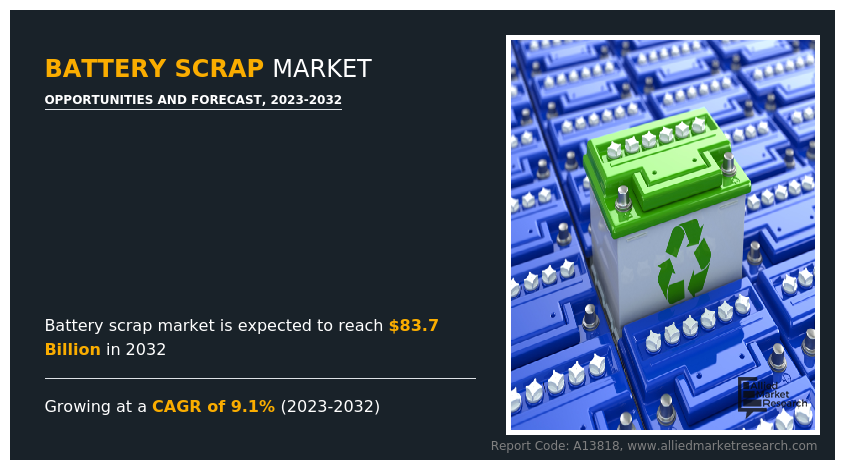
Battery scrap refers to discarded or used batteries that are no longer functional and are considered waste. Batteries are available in various types, including alkaline batteries, rechargeable batteries (such as lithium-ion batteries), lead acid batteries (commonly used in vehicles), and more. When these batteries reach the end of their useful life, they become battery scrap. Battery scrap can pose environmental and safety hazards if not properly managed and recycled. Many types of batteries contain hazardous materials, such as heavy metals like lead, cadmium, and mercury, which can be harmful to the environment and human health if they leach into soil and water. Recycling battery scrap is essential to reduce the environmental impact and recover valuable materials.
The growing demand for batteries across various sectors, including consumer electronics, electric vehicles (EVs), renewable energy storage, and industrial applications, leads to a higher volume of used batteries entering the scrap market. Also, government incentives, subsidies, and policies promoting battery recycling contribute to the growth of the battery scrap market. These initiatives include extended producer responsibility (EPR) programs and financial incentives for recyclers. However, one of the significant challenges faced by the battery scrap market is hazardous materials handling and recycling costs. Nevertheless, rise in demand for electric vehicles (EVs) and energy storage is anticipated to offer many opportunities for the battery scrap market growth in the coming years.
The battery scrap market scope is segmented on the basis of product type, source, end use, and region. By product type, the market is categorized into lead acid, lithium-ion, and others. By source, the battery scrap market is classified into electric vehicles, consumer electronics, power tools, and others. By end use, the market is categorized into material extraction, reuse, disposal, and others. By region, the market is analyzed across North America, Europe, Asia-Pacific, and LAMEA.
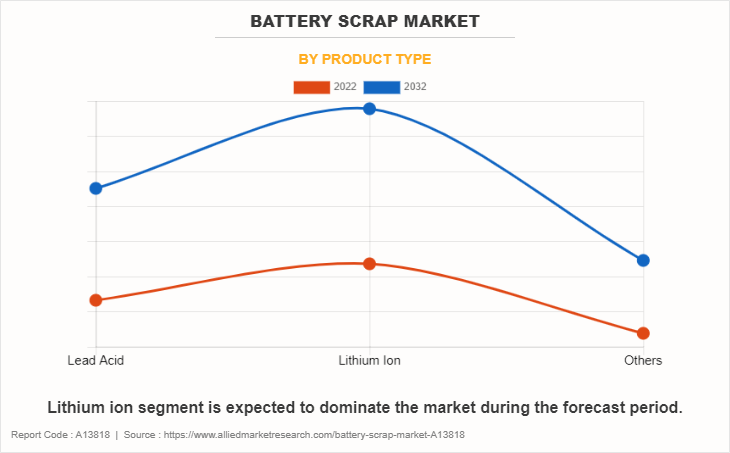
Based on product type, the lithium-ion segment held the highest market share in 2022, accounting for nearly half of the global battery scrap market share, in terms of revenue, and is estimated to maintain its leadership status throughout the forecast period. Lithium-ion batteries are widely used in various applications, including consumer electronics, electric vehicles (EVs), renewable energy storage systems, and portable devices due to their high energy density and rechargeable nature.
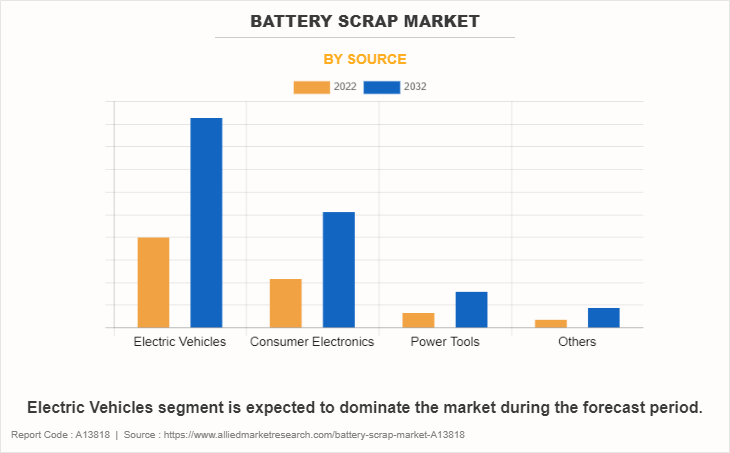
Based on source, electric vehicle segment held the highest market share in 2022, accounting for nearly three-fifths of the global battery scrap market size in terms of revenue, and is estimated to maintain its leadership status throughout the forecast period. Electric vehicles (EVs) contribute to the battery scrap market primarily through the replacement of their lithium-ion batteries. Recycling and repurposing these used EV batteries play a crucial role in resource conservation, environmental sustainability, and responsible growth of the electric vehicle sector, which have significant impact on the battery scrap industry.
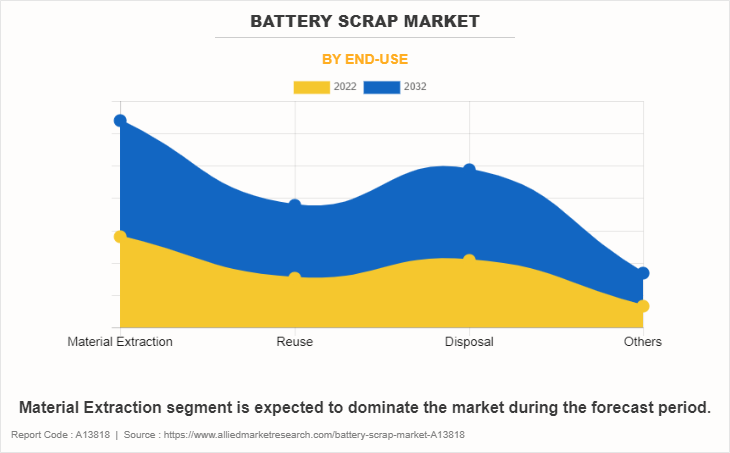
Based on the end-use, the material extraction held the highest market share in 2022, accounting for nearly two-fifths of the global battery scrap market revenue, and are estimated to maintain their leadership status throughout the forecast period. Battery scrap can have several potential uses in the field of material extraction, primarily in recycling and repurposing batteries and their components.
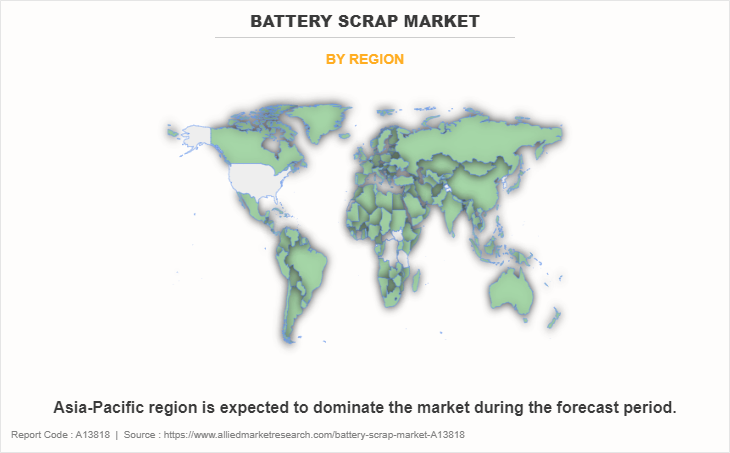
Based on region, Asia-Pacific held the highest market share in terms of revenue in 2022, accounting for nearly half of the global market revenue, and is likely to dominate the battery scrap market forecast. The Asia-Pacific region has been at the forefront of electric vehicle adoption, with China being the largest EV market globally. Thus, there has been a growing focus on the recycling of EV batteries to recover valuable materials such as lithium, cobalt, and nickel. The abovementioned factors will provide battery scrap market opportunities for the development of the market.
Competitive Landscape
Key players in the battery scrap industry include Li-Cycle, Umicore, HUSKY BATTERY SOLUTIONS, ENGITEC TECHNOLOGIES SPA, Sunlight Group, Aqua Metals, Inc., Ecobat, EXIDE INDUSTRIES LTD., Guangdong Brunp Recycling Technology Co., Ltd., and Gravita India Ltd. The key manufacturers operating in the battery scrap market have adopted strategies such as product innovation, joint venture, expansion, partnership, agreement, investment, and collaboration to increase their market share.
Key Benefits For Stakeholders
- This report provides a quantitative analysis of the market segments, current trends, estimations, and dynamics of the battery scrap market analysis from 2022 to 2032 to identify the prevailing battery scrap market opportunities.
- The market research is offered along with information related to key drivers, restraints, and opportunities.
- Porter's five forces analysis highlights the potency of buyers and suppliers to enable stakeholders make profit-oriented business decisions and strengthen their supplier-buyer network.
- In-depth analysis of the battery scrap market segmentation assists to determine the prevailing market opportunities.
- Major countries in each region are mapped according to their revenue contribution to the global market.
- Market player positioning facilitates benchmarking and provides a clear understanding of the present position of the market players.
- The report includes the analysis of the regional as well as global battery scrap market trends, key players, market segments, application areas, and market growth strategies.
Battery Scrap Market Report Highlights
| Aspects | Details |
| Market Size By 2032 | USD 83.7 billion |
| Growth Rate | CAGR of 9.1% |
| Forecast period | 2022 - 2032 |
| Report Pages | 360 |
| By Product type |
|
| By Source |
|
| By End-use |
|
| By Region |
|
| Key Market Players | Umicore, EXIDE INDUSTRIES LTD., ENGITEC TECHNOLOGIES SPA, Aqua Metals, Inc., Ecobat, Sunlight Group, Guangdong Brunp recycling Technology Co., Ltd., Li-Cycle, Gravita India Ltd., Husky Battery Solutions Ltd. |
Analyst Review
According to the opinions of various CXOs of leading companies, the battery scrap market is expected to witness increase in demand due to growing demand for electric vehicles and energy storage systems during the forecast period. Energy storage systems (ESS) are used to store electricity, provide grid stability, support renewable energy integration, and offer backup power during outages. They typically employ large batteries, such as lithium-ion batteries. ESS batteries have a finite lifespan, similar to EV batteries. They are designed to operate for a certain number of charge and discharge cycles, after which their capacity declines. When ESS batteries reach the end of their life cycle for their intended energy storage use, they can either be replaced or repurposed. In many cases, used ESS batteries still retain a significant portion of their original capacity and can be repurposed for less demanding applications.
Increase in the deployment of renewable energy sources, such as solar and wind power, drives the demand for ESS. As the renewable energy sector grows, so does the availability of used ESS batteries for recycling, creating opportunities for the battery scrap market growth.
Further, technological developments in battery recycling and scrap management are crucial for improving the efficiency, sustainability, and economic viability of the battery scrap market. Several innovative technologies and approaches have emerged to address the challenges associated with recycling various types of batteries. For instance, innovative methods for recovering lithium from used batteries are becoming more efficient. These technologies are crucial due to increase in demand for lithium in various industries. Also, some battery manufacturers are designing batteries with modular components that can be easily replaced or upgraded. This design simplifies recycling and makes it easier to recover valuable materials.
Increased EV adoption, Circular economy practices, Advanced recycling technologies, Green recycling methods, and Battery-to-battery recycling are the upcoming trends of Battery Scrap Market in the world.
Electric Vehicle is the leading application of battery scrap market.
Asia-Pacific is the largest regional market for battery scrap.
$83.7 billion is the estimated industry size of battery scrap.
Li-Cycle, Umicore, Sunlight Group, Aqua Metals, Inc., and Ecobat are the top companies to hold the market share in battery scrap.
Loading Table Of Content...
Loading Research Methodology...


